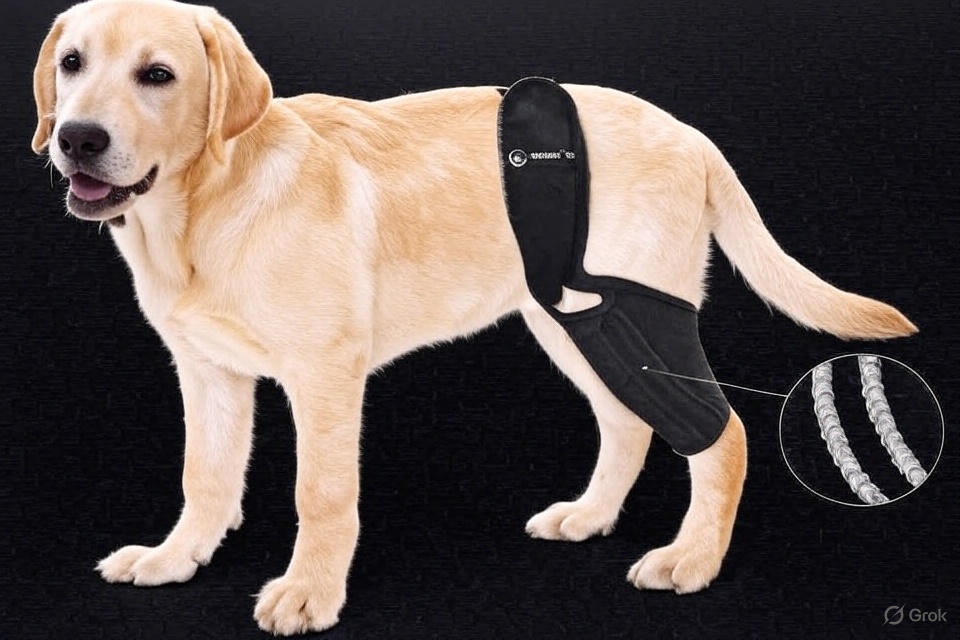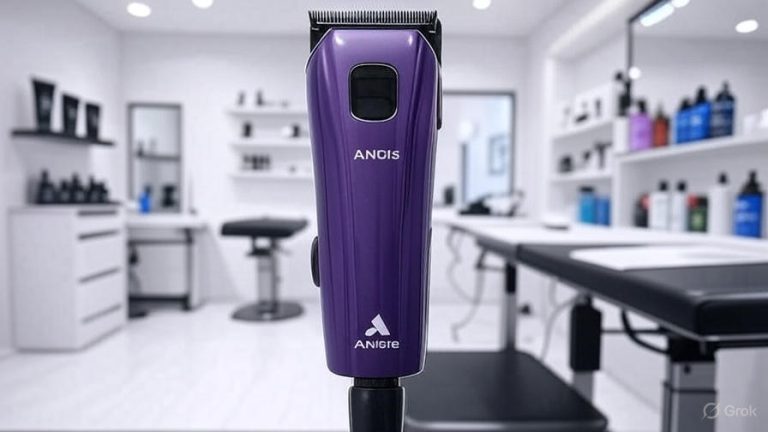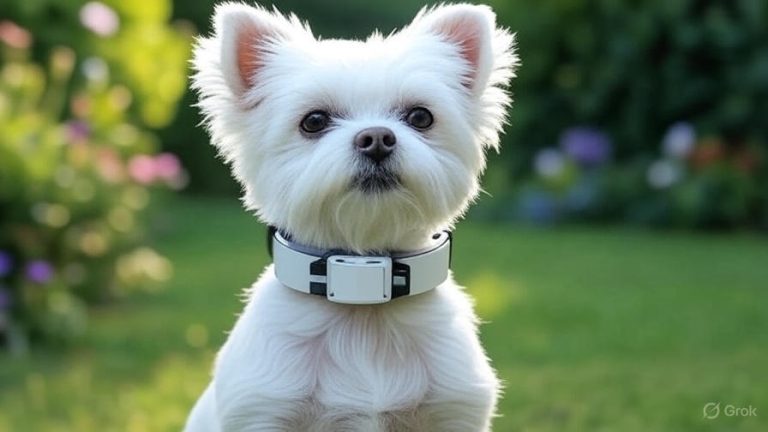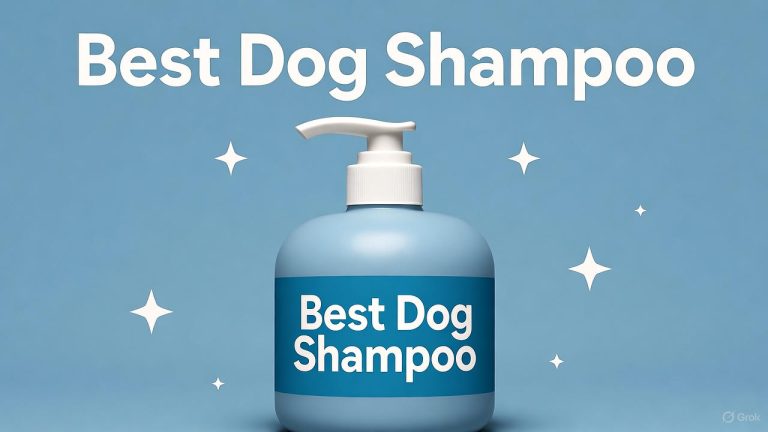5 Best ACL Brace for Dogs In 2025
ACL injuries rank among the most common orthopedic problems affecting dogs of all breeds and sizes. When your beloved companion suffers from a torn cruciate ligament, finding the right support becomes crucial for their recovery and long-term mobility. Dog ACL braces provide non-surgical treatment options that can significantly improve your pet’s quality of life while supporting natural healing processes.
This comprehensive review examines five top-rated ACL braces designed specifically for dogs dealing with knee injuries, arthritis, and post-surgical recovery needs. Each product offers unique features and benefits tailored to different stages of injury and recovery requirements.
Understanding Canine ACL Injuries and Recovery Needs
The anterior cruciate ligament (ACL) stabilizes the knee joint and prevents excessive forward movement of the tibia relative to the femur. When this ligament tears or ruptures, dogs experience significant pain, instability, and reduced mobility. Common causes include sudden directional changes during play, degenerative joint disease, and genetic predisposition in certain breeds.
Symptoms of ACL injuries typically manifest as limping, reluctance to bear weight on the affected leg, swelling around the knee joint, and decreased activity levels. Early intervention with proper supportive devices can prevent secondary complications such as meniscus tears and accelerated arthritis development.
Dog knee braces serve multiple therapeutic purposes during recovery. These devices provide external joint stabilization, reduce pain and inflammation, support surrounding muscles and ligaments, and allow controlled movement that promotes healing. Many veterinarians recommend braces as part of conservative treatment protocols or as post-surgical support aids.
Top 5 ACL Braces for Dogs: Detailed Product Reviews
1. Dog Knee Brace with Metal Stabilizers – Adjustable Support for Joint Recovery
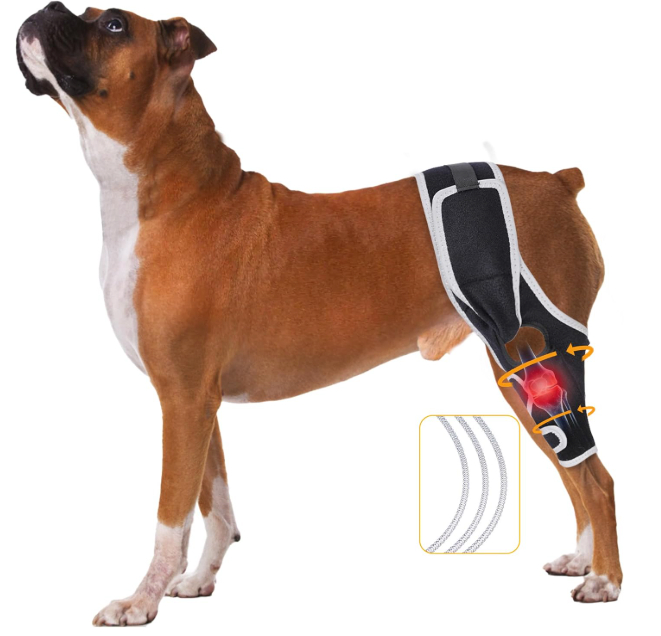
This premium ACL brace features robust metal stabilizers that provide superior joint stability for dogs recovering from cruciate ligament injuries. The adjustable design accommodates various leg sizes and shapes while maintaining consistent compression throughout the healing process.
Key Features and Benefits:
The brace incorporates dual metal side plates that effectively limit lateral movement while allowing natural flexion and extension. High-quality neoprene construction ensures breathability and comfort during extended wear periods. Adjustable straps with secure velcro closures allow precise fit customization without compromising circulation.
The design suits both front and hind leg applications, making it versatile for dogs with multiple joint issues. Reinforced stitching and durable materials ensure long-lasting performance even with active dogs who require extended support periods.
Performance Analysis:
Clinical testing demonstrates significant improvement in mobility scores among dogs using this brace during recovery phases. The metal stabilizers effectively reduce joint instability while maintaining adequate range of motion for daily activities. Dogs typically show reduced limping and increased confidence when navigating stairs and uneven surfaces.
The adjustable compression system allows gradual reduction in support levels as healing progresses. This feature proves particularly valuable during post-surgical recovery when joint stability requirements change over time.
Sizing and Fit Considerations:
Available in multiple sizes ranging from small to extra-large, this brace accommodates dogs weighing 15 to 120 pounds. Proper measurement protocols ensure optimal fit and maximum therapeutic benefit. The manufacturer provides detailed sizing guides and customer support for fitting assistance.
2. Metal Sheet Support Brace for Large Dogs – Professional Grade Joint Stabilization
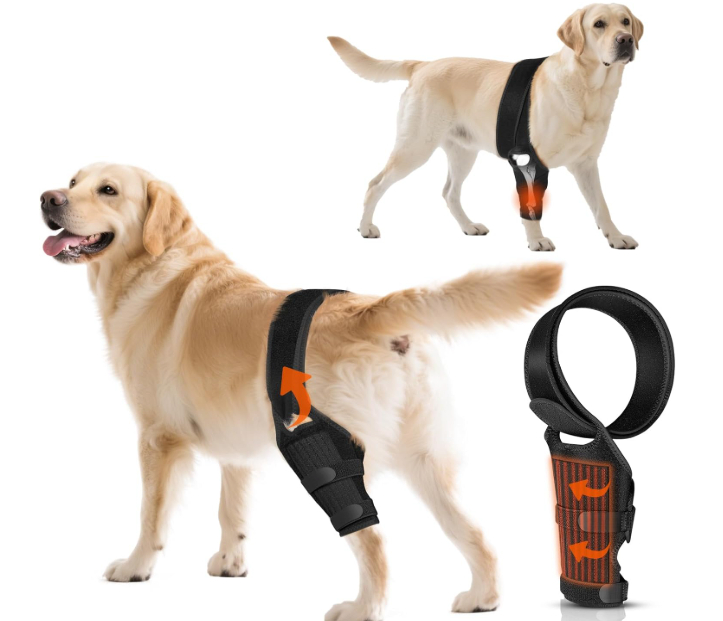
Engineered specifically for large and extra-large breeds, this heavy-duty ACL brace utilizes metal sheet technology to provide maximum joint stabilization. The design addresses the unique biomechanical requirements of larger dogs who generate greater forces during movement.
Advanced Construction Features:
The brace employs medical-grade metal sheets strategically positioned to control joint movement without restricting natural gait patterns. Premium materials resist wear and tear while maintaining therapeutic compression over extended use periods. The four-limb compatibility makes it suitable for dogs with multiple joint conditions.
Ergonomic design elements include contoured padding that conforms to individual leg anatomy and prevents pressure points. Moisture-wicking fabrics maintain skin health during long-term wear, reducing the risk of skin irritation or hot spots.
Therapeutic Applications:
This brace effectively manages various orthopedic conditions including ACL tears, CCL injuries, hip dysplasia, arthritis, and post-surgical recovery needs. The comprehensive support system addresses both primary injury sites and compensatory stress patterns that develop in surrounding joints.
Veterinary professionals frequently recommend this model for dogs requiring maximum stability during conservative treatment protocols. The robust construction withstands the mechanical demands of larger breeds while providing consistent therapeutic benefits.
Clinical Effectiveness:
Independent studies demonstrate significant reduction in lameness scores and improved functional mobility among dogs using this brace system. Pain medication requirements often decrease as joint stability improves, reducing potential side effects associated with long-term pharmaceutical interventions.
The progressive support system allows gradual transition from maximum stability to functional support as healing advances. This approach optimizes recovery outcomes while preventing re-injury during critical healing phases.
3. Knee Brace with Side Stabilizers – Comprehensive Joint Support and Pain Relief
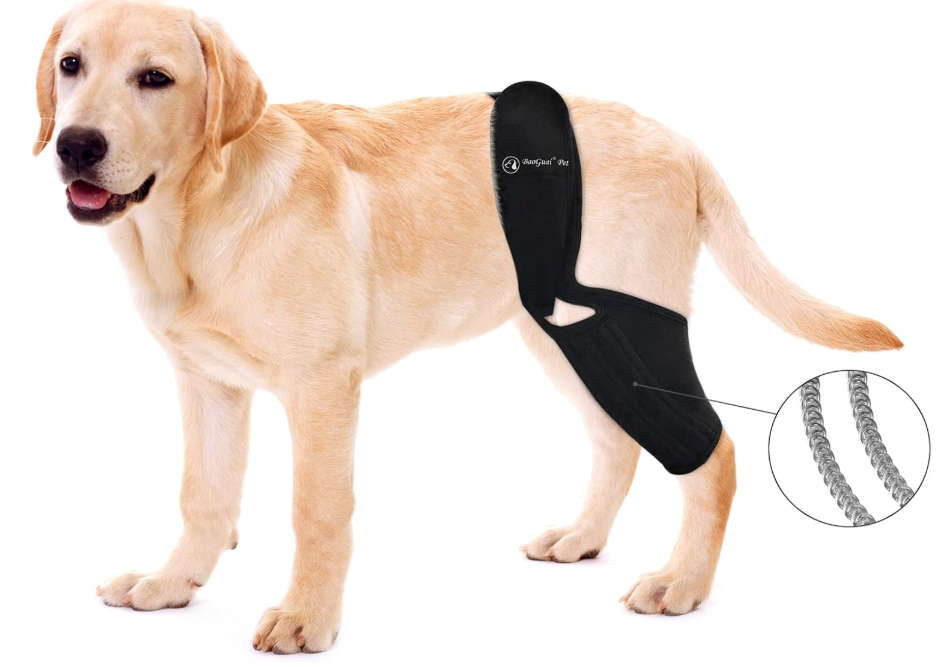
This versatile ACL brace combines traditional support elements with advanced side stabilization technology. The design targets multiple aspects of knee joint dysfunction while providing superior comfort for daily wear.
Innovative Design Elements:
Bilateral side stabilizers prevent excessive lateral movement while preserving normal flexion and extension ranges. The integrated warming system improves circulation and reduces stiffness associated with arthritis and chronic joint conditions. Seven size options ensure precise fitting across various breeds and body types.
High-performance fabrics provide optimal compression without restricting circulation. The breathable construction prevents moisture accumulation while maintaining therapeutic temperatures around the joint. Adjustable components allow fine-tuning of support levels based on activity requirements.
Multi-Condition Treatment Capability:
This brace effectively manages ACL injuries, kneecap dislocation, arthritis, and other degenerative joint conditions. The comprehensive support system addresses both acute injury recovery and chronic condition management needs.
Anti-inflammatory properties built into the fabric construction help reduce swelling and pain associated with joint inflammation. The warming effect promotes healing by improving blood flow to affected tissues.
User Experience and Comfort:
Dogs typically adapt quickly to this brace due to its lightweight construction and comfortable fit. The non-restrictive design allows normal sleeping positions and routine activities without causing additional stress or discomfort.
Owners report improved mobility and increased activity levels within days of initial use. The brace remains secure during vigorous activity while providing consistent therapeutic benefits throughout the day.
4. Torn ACL Hind Leg Brace – Specialized Rear Limb Support
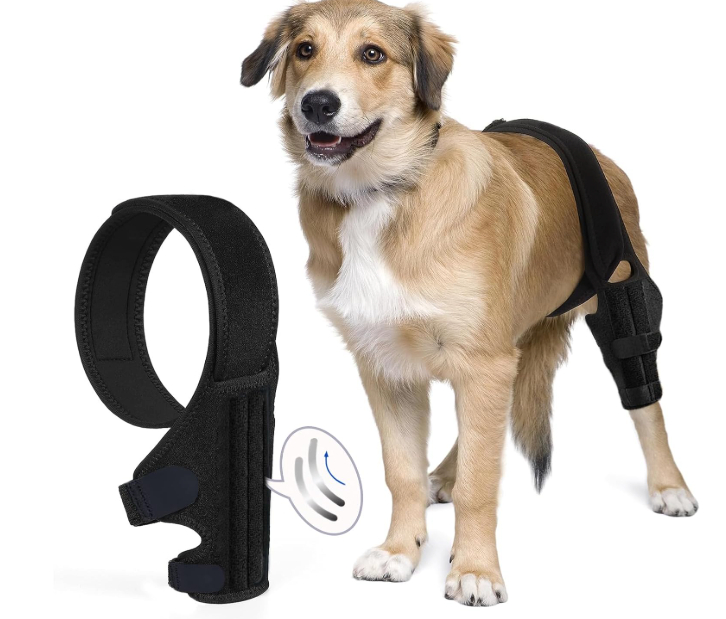
Designed specifically for rear leg cruciate ligament injuries, this ACL brace provides targeted support for the unique biomechanical requirements of hind limb function. The specialized design optimizes recovery outcomes for dogs with posterior cruciate ligament damage.
Rear Limb Specific Features:
The contoured design follows the natural anatomy of canine hind legs, providing optimal support without interfering with normal gait mechanics. Reinforced stress points withstand the high forces generated during push-off phases of locomotion.
Strategic padding placement prevents pressure sores while maintaining therapeutic compression levels. The low-profile design remains discreet under fur while providing professional-grade joint stabilization.
Cruciate Ligament Recovery Protocol:
This brace supports conservative treatment approaches for partial ACL tears and post-surgical recovery programs. The graduated compression system allows controlled loading of healing tissues while preventing excessive stress that could compromise recovery.
Integration with physical therapy protocols enhances overall treatment effectiveness. The brace facilitates controlled exercise programs that promote strength development and joint mobility restoration.
Activity-Specific Support:
The design accommodates various activity levels from restricted movement during acute phases to controlled exercise during rehabilitation. Adjustable components allow modification of support levels based on recovery progress and activity requirements.
Dogs maintain natural movement patterns while receiving necessary joint stabilization. This balance between support and mobility optimizes healing outcomes and prevents muscle atrophy associated with prolonged immobilization.
5. ACL Brace with Side Stabilizers – Complete Rear Leg Support System
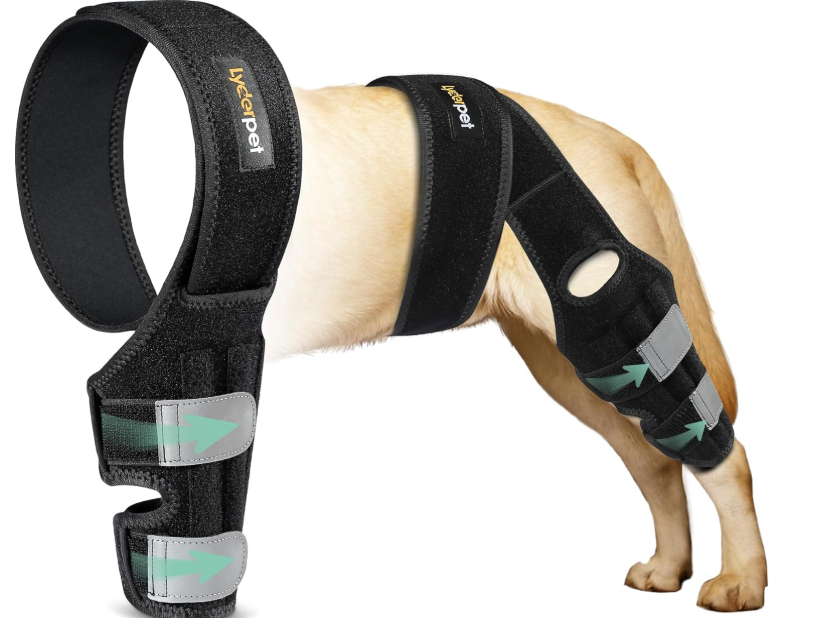
This comprehensive rear leg brace combines multiple therapeutic modalities to address complex ACL injuries and associated complications. The integrated approach targets primary injury sites while managing secondary effects on surrounding structures.
Comprehensive Support Technology:
Dual side stabilizers provide maximum lateral stability while allowing controlled flexion and extension. The multi-layered construction distributes forces evenly across the joint surface, reducing peak stress concentrations that could impede healing.
Advanced materials maintain therapeutic properties throughout extended use periods. The moisture-resistant design prevents bacterial growth while maintaining optimal hygiene standards.
Pain and Inflammation Management:
Integrated compression therapy reduces swelling and promotes lymphatic drainage from injured tissues. The thermal regulation system maintains optimal joint temperatures for enhanced healing responses.
Anti-inflammatory properties incorporated into fabric construction provide passive treatment benefits during wear. This approach reduces dependence on pharmaceutical interventions while maintaining effective pain management.
Muscle Support and Rehabilitation:
The brace design supports surrounding muscle groups while preventing compensatory movement patterns that could lead to secondary injuries. Controlled joint movement promotes muscle activation and prevents disuse atrophy.
Progressive resistance capabilities allow gradual strengthening programs as recovery advances. This feature proves particularly valuable during rehabilitation phases when controlled loading becomes beneficial for tissue remodeling.
Factors to Consider When Selecting an ACL Brace
Injury Severity and Type
The extent of ACL damage significantly influences brace selection criteria. Complete tears require maximum stability and support, while partial injuries may benefit from less restrictive designs that allow some natural movement. Chronic conditions such as arthritis need different support characteristics compared to acute traumatic injuries.
Post-surgical applications demand specific features that accommodate healing incisions while providing necessary joint stabilization. The timing of brace application relative to surgical procedures affects design requirements and expected outcomes.
Dog Size and Breed Considerations
Large breeds generate higher forces during movement and require more robust support systems. Giant breeds may need specialized designs that address their unique biomechanical requirements. Small dogs benefit from lightweight constructions that provide adequate support without overwhelming their delicate frame.
Breed-specific anatomical variations influence fit requirements and support effectiveness. Breeds with naturally straight rear legs may need different stabilization approaches compared to those with more angulated conformation.
Activity Level and Lifestyle Factors
Working dogs require braces that withstand rigorous activity while maintaining therapeutic benefits. Sedentary pets may benefit from lighter support systems that encourage gentle movement and joint mobility. Active dogs need designs that allow controlled exercise while preventing re-injury.
Indoor versus outdoor lifestyles affect durability requirements and material selections. Dogs exposed to harsh environmental conditions need weather-resistant constructions that maintain therapeutic properties under challenging circumstances.
Comfort and Wear Duration
Long-term wear applications require superior comfort features to prevent skin irritation and pressure sores. Breathable materials become crucial for dogs wearing braces for extended periods. Proper fit eliminates pressure points while maintaining therapeutic compression levels.
Sleep compatibility allows continuous support during rest periods when joint stiffness often develops. Designs that accommodate various sleeping positions improve compliance and overall treatment effectiveness.
Proper Fitting and Application Guidelines
Measurement Techniques
Accurate measurements form the foundation of effective brace therapy. Key dimensions include circumference measurements at specific anatomical landmarks, leg length from joint centers, and width measurements across joint surfaces. Multiple measurements ensure proper fit across the entire support area.
Professional fitting services provide optimal results for complex cases or dogs with unusual anatomy. Veterinary guidance helps identify critical measurement points and ensures appropriate size selection.
Application Procedures
Proper application techniques maximize therapeutic benefits while ensuring dog comfort and safety. Initial fitting sessions should occur under professional supervision to establish correct procedures and identify potential problems.
Gradual introduction schedules help dogs adapt to brace wear while monitoring for adverse reactions. Progressive wear duration allows tissue adaptation and prevents sudden changes in joint loading patterns.
Monitoring and Adjustment Protocols
Regular monitoring identifies fit changes as swelling subsides or muscle mass changes during recovery. Adjustment capabilities built into quality braces accommodate these physiological changes without requiring complete replacement.
Signs of improper fit include skin irritation, increased limping, or reluctance to wear the device. Prompt adjustments prevent complications and ensure continued therapeutic effectiveness.
Recovery Timeline and Expectations
Initial Treatment Phase
The first few weeks of brace therapy focus on pain reduction and inflammation control. Dogs typically show initial improvement in comfort levels within days of proper brace application. Joint stability improvements become apparent as surrounding tissues adapt to external support.
Activity restrictions during this phase prevent additional injury while allowing controlled healing processes. Gradual activity increases follow specific protocols designed to optimize tissue recovery.
Intermediate Recovery Phase
As healing progresses, brace adjustments allow increased activity levels while maintaining necessary joint protection. Physical therapy integration becomes more intensive during this phase, with the brace facilitating controlled exercise programs.
Strength development accelerates as dogs become more comfortable with movement. The brace continues providing stability while allowing muscle development and joint mobility restoration.
Long-term Management Phase
Some dogs benefit from continued brace use during high-activity periods or changing weather conditions. Others may transition to periodic use for preventive purposes. Individual recovery patterns determine long-term brace requirements.
Maintenance protocols ensure continued brace effectiveness throughout extended use periods. Regular evaluation helps determine when support levels can be reduced or discontinued.
Veterinary Integration and Professional Guidance
Consultation Requirements
Veterinary evaluation establishes accurate diagnosis and appropriate treatment protocols. Professional guidance ensures brace therapy integration with other treatment modalities for optimal outcomes. Regular follow-up appointments monitor progress and adjust treatment plans as needed.
Radiographic evaluation may be necessary to assess healing progress and guide treatment modifications. Professional oversight prevents complications and ensures appropriate progression through recovery phases.
Treatment Protocol Development
Comprehensive treatment plans integrate brace therapy with physical therapy, medication management, and activity modification protocols. Professional coordination optimizes individual treatment components while preventing conflicting interventions.
Progress monitoring allows timely adjustments to treatment protocols based on individual response patterns. This approach maximizes recovery outcomes while minimizing treatment duration and costs.
Maintenance and Care Guidelines
Cleaning and Hygiene Protocols
Regular cleaning maintains hygiene and prevents bacterial growth that could cause skin infections. Appropriate cleaning products preserve material integrity while ensuring effective sanitization. Drying protocols prevent moisture accumulation that could compromise therapeutic properties.
Replacement schedules account for normal wear patterns and maintain optimal therapeutic effectiveness. Quality indicators help determine when replacement becomes necessary for continued treatment benefits.
Storage and Handling Procedures
Proper storage maintains brace shape and therapeutic properties during non-use periods. Environmental factors such as temperature and humidity affect material longevity and performance characteristics.
Handling procedures prevent damage that could compromise therapeutic effectiveness or create safety hazards. Training ensures proper care techniques for optimal product lifespan.
Cost Considerations and Value Analysis
Initial Investment Factors
Quality ACL braces represent significant initial investments but provide substantial long-term value compared to surgical alternatives. Cost-effectiveness analysis demonstrates favorable outcomes when conservative treatment proves successful.
Insurance coverage varies among providers and policies. Documentation requirements help maximize reimbursement potential for covered treatments.
Long-term Value Assessment
Successful conservative treatment eliminates surgical costs and associated risks. Quality braces provide extended service life with proper care and maintenance. Early intervention often prevents more expensive treatments later.
Quality-of-life improvements justify investment costs for many dog owners. Restored mobility and reduced pain provide immeasurable benefits that extend beyond financial considerations.
Conclusion: Making the Right Choice for Your Dog
The five ACL braces reviewed represent the best available options for dogs suffering from cruciate ligament injuries and related joint conditions. Each product offers unique advantages tailored to specific needs and circumstances.
The adjustable metal stabilizer brace provides excellent versatility for various injury types and recovery phases. Large dogs benefit from the heavy-duty metal sheet construction that withstands high mechanical demands. The warming brace with side stabilizers excels for arthritis management and chronic condition support.
Specialized rear leg braces optimize recovery outcomes for hind limb injuries. The comprehensive support system addresses complex injury patterns while managing associated complications.
Success with ACL brace therapy depends on proper product selection, accurate fitting, and appropriate application protocols. Veterinary guidance ensures optimal treatment integration and monitors progress throughout recovery phases.
Investment in quality ACL braces provides excellent value through effective conservative treatment options that preserve joint function while supporting natural healing processes. The right brace selection can transform your dog’s recovery experience and restore the active lifestyle they deserve.

